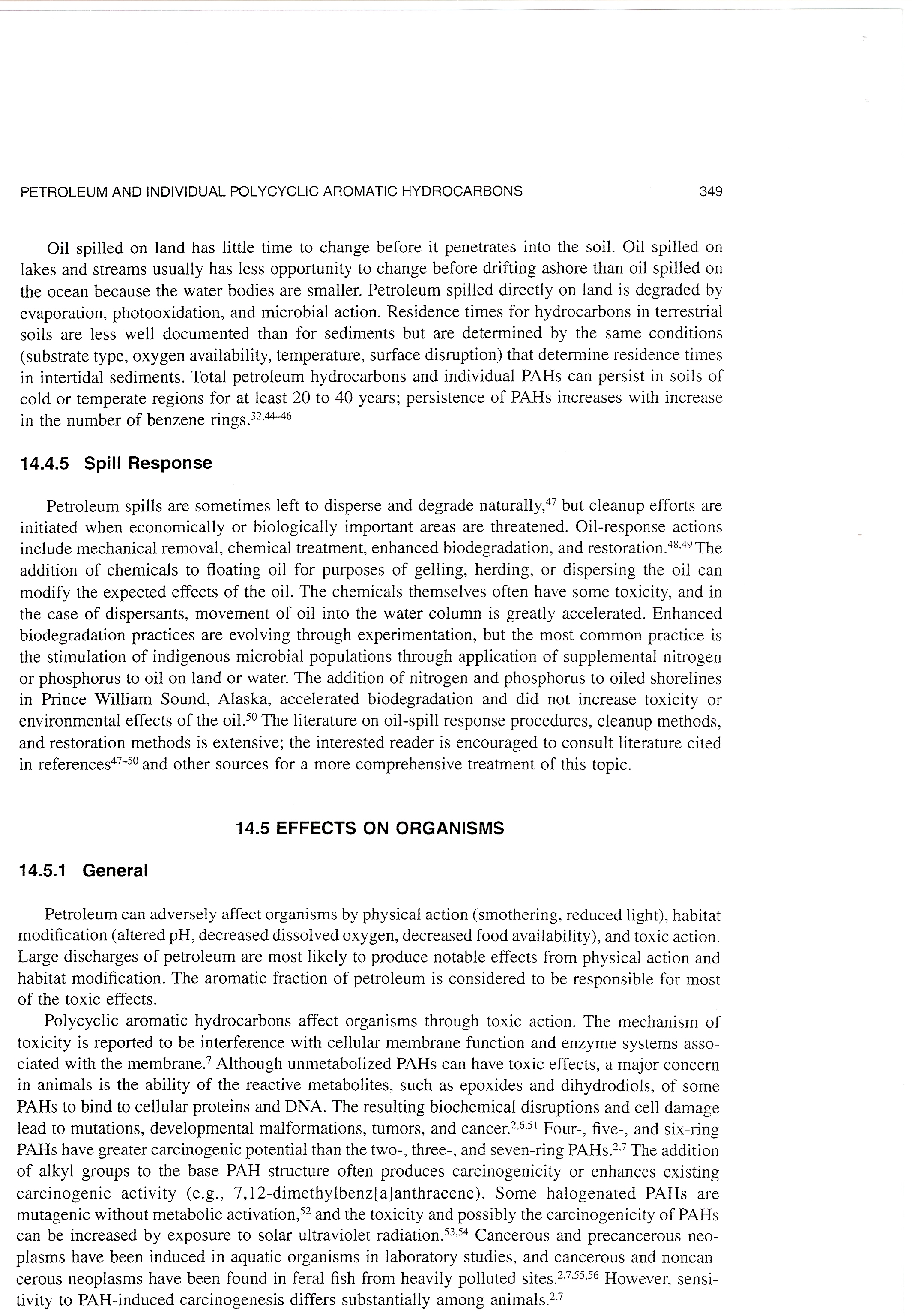scan0020 (6)

349
PETROLEUM AND INDMDUAL POLYCYCLIC AROMATIC HYDROCARBONS
Oil spilled on land has little time to change before it penetrates into the soil. Oil spilled on lakes and streams usually has less opportunity to change before drifting ashore than oil spilled on the ocean because the water bodies are smaller. Petroleum spilled directly on land is degraded by evaporation, photooxidation, and microbial action. Residence times for hydrocarbons in terrestrial soils are less well documented than for sediments but are determined by the same conditions (substrate type, oxygen availability, temperaturę, surface disruption) that determine residence times in intertidal sediments. Total petroleum hydrocarbons and individual PAHs can persist in soils of cold or temperate regions for at least 20 to 40 years; persistence of PAHs increases with increase in the number of benzene rings.3*44-46
14.4.5 Spili Response
Petroleum spills are sometimes left to disperse and degrade naturally,47 but cleanup efforts are initiated when economically or biologically important areas are threatened. Oil-response actions include mechanical removal, Chemical treatment, enhanced biodegradation, and restoration.48-49The addition of Chemicals to floating oil for purposes of gelling, herding, or dispersing the oil can modify the expected effects of the oil. The Chemicals themselves often have some toxicity, and in the case of dispersants, movement of oil into the water column is greatly accelerated. Enhanced biodegradation practices are evolving through experimentation, but the most common practice is the stimulation of indigenous microbial populations through application of supplemental nitrogen or phosphorus to oil on land or water. The addition of nitrogen and phosphorus to oiled shorelines in Prince William Sound, Alaska, accelerated biodegradation and did not increase toxicity or environmental effects of the oil.50 The literaturę on oil-spill response procedures, cleanup methods, and restoration methods is extensive; the interested reader is encouraged to consult literaturę cited in references47-50 and other sourees for a morę comprehensive treatment of this topie.
14.5 EFFECTS ON ORGANISMS
14.5.1 General
Petroleum can adversely organisms by physical action (smothering, reduced light), habitat modification (altered pH, decreased dissolved oxygen, decreased food availability), and toxic action. Large discharges of petroleum are most likely to produce notable effects from physical action and habitat modification. The aromatić fr&ćtion of petroleum is considered to be responsible for most of the toxic effects.
Polyc^ęliii aromatić hydrocarbons afiśśsli organisms through tox®ś action. The mechanism of toxicity is reported to be interferenee with cellular membranę function and enzyme iystems asso-ciated with the membranę.7 AIthough unmetabolized PAHs can have toxic effects, a major concem in animals is the ability of the reactive metabolites, such as epoxides and dihydrodiols, of some PAHs to bind to cellular proteipp and DNA. The resulting biochemical disruptions and celi damage lead tą mutations, developmental malformations, tumors, and cancetiP* Four-, fi\>e-, and six-ring PAHs have greater carcinogenić potential than the two-, three-, and seven-ring PAHs.2-7 The addition of alkyl groups to the base PAH structure often produces carcinogenicity or enhances existing ttśieinogenic activi|v ife.g., ?,12-dimethylbenz[a]anthracene). Some halcpbnated PAHs are fiutagenic without metabolic activation*52 and the toxicity and possibly the carcinogenici||i|f PAH| can be inereased by exposure- to solar ultraviolet radiation.53# Cancerous and precancerpns neo-plasms have been induced in aąuatii organisms in laboratory studies, and cancerous and nonean-' cerous neoplasms have been found in feral fish from heavily polluted sites?-?'55-56 However, sensi-tivify’ to PAH-induced ^rGińogenesiS differs substantially among animals.*7
Wyszukiwarka
Podobne podstrony:
scan0016 (7) 345 PETROLEUM AND INDMDUAL POLYCYCLIC AROMATIC
scan0018 (7) PETROLEUM AND INDMDUAL POLYCYCLIC AROMATIC
39447 scan0025 (4) Volume 34/Numbcr ll/November 1997 <3ffl -3 to-1 Om Fig. 1 Comparison of polycy
67 (43) 7. Mask and paint second border yellow. Sponge coral on outer edge of
UA1V/^I UjyiUV
scan0017 (7) 346 HANDBOOK OF ECOTOXICOLOGY Figurę 14.4 Sources of petroleum and PAHs in the environm
ivwiv^i V>llV^O JLJl ISillSgl CłJ/lilljUlO Wakeham S.G., Schaffner C., Giger W., 1980a. Polycycli
22634 scan0033 (3) Volume 34/Number ll/Novcmbcr 1997 Yaldez Oil Spili: Fate and Ęffects in Alaskan W
UHAM095 78 ^ UNDERSTANDING HEADACHES AND M I G RAI N ES Aromatherapy: There are many aromatherapy as
07-1-10 Wykład 13 Wielopierścieniowe Węglowodory Aromatyczne (Policyclic Aromatic Hydrocarbons) •
więcej podobnych podstron